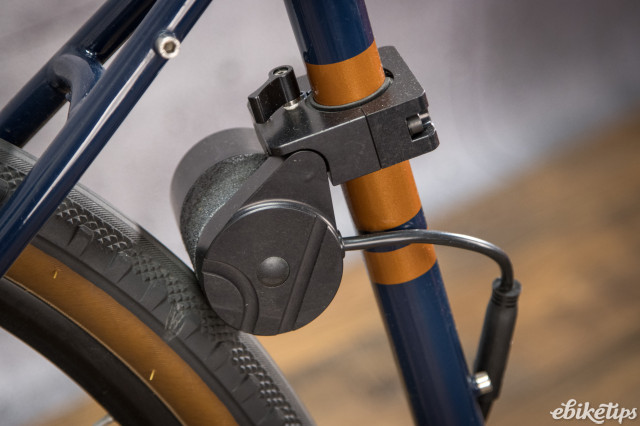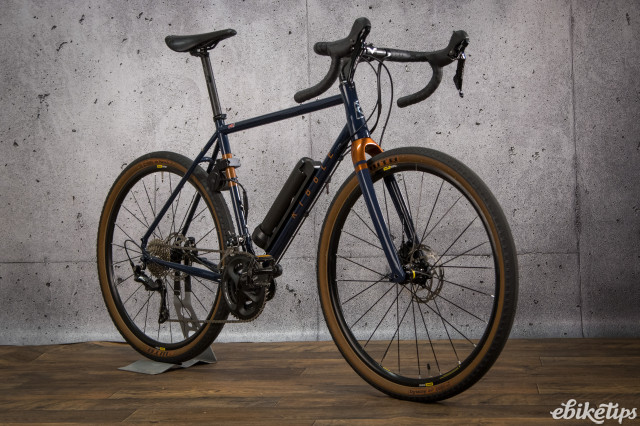Revos eBike Kit With 200Wh Battery

Overview
- Simple to fit
- Easy to use your bike without power
- Light
- Not especially powerful
- Range is limited
- Won’t fit all bikes
If you’ve got a bike you’re fond of, but you want to add a bit of assistance to make the commute or leisure rides easier, then some kind of conversion kit is the way to go. We’ve previously tested the Swytch kit which uses a bar-mounted battery and a hub motor, and that’s pretty effective. The Revos system is an alternative: Instead of using a motor in the wheel, it’s based on a friction drive unit.
Friction drive? Basically the motor is in contact with the rear tyre, and it directly drives the tyre when you’re pedalling. The motor itself is tiny, and the drive surface has a roughened texture, a bit like a coarse grit sandpaper, that allows for good friction between the wheel and the motor in all conditions. The motor is driven by a bottle-cage-mounted battery, and there’s a cadence sensor which you fit to the crank to allow the motor to only assist you when you’re pedalling, as is required by law. And that’s it: it’s a very simple system, and it’s nice and light. Our motor system with a 200Wh battery weighed in at just 2.7kg. That’s basically as light a system as you can fit.
Fitting the system is simplicity itself, with the proviso that it’ll depend to a certain extent on what you’re fitting it to. The motor unit clamps to the seat tube, and it’s designed to accommodate a standard diameter circular tube, so if you’re fitting the Revos to a steel-framed bike, or anything that uses a standard round seatpost, you’re probably going to be fine. You need a 50mm gap between the tube and the rear wheel, and the maximum external tube diameter is 35mm. If your bike has a hydroformed seat tube, though, or uses an aero seatpost, then you’re likely to run out of luck. Realistically this system is designed to be fitted to something like a city bike or a single speed, with metal tubes and pretty standard geometry. We fixed it to a Ribble CGR 725 gravel bike and the whole setup of the system took about 20 minutes from the box to clipping off the ends of the cable ties. It really is super simple.
The motor sits behind the seat tube, and you move it into contact with the tyre using a grub screw with a small lever. It’s a bit of a faff but it’s easy enough once you get the hang of it. If you want to run the bike without power it’s simple enough to move the motor so it’s no longer in contact with the wheel. The motor is pivoted, and when the power kicks in, that pushes the drive wheel into closer contact with the tyre for better transfer of power. When you’re coasting the motor moves back for minimal resistance. You don’t really notice the resistance when you’re freewheeling.
You might be looking at the motor unit and thinking, “that doesn’t look very powerful,” and in all honesty it’s not. You’re not going to get mid-motor levels of assistance from something as tiny as the Revos, and it’s less powerful than, say, the hub motor in the Swytch system. That being said, it does make a meaningful difference to your progress. On the flat the motor can take most of the strain if you want it to, and when you reach a hill it’s still contributing a bit of effort to help you on your way. Because it’s contacting at the tyre, it’s spinning much more quickly than a hub motor would for the same ground speed, and that does appear to help a bit with the torque response: it doesn’t fall off as quickly as some hub motors do when you’re winching yourself up a climb. The Revos is best when the gradient doesn’t go over about 5%, and after that it starts to suffer a bit, so if your commute includes lots of steep hills, it’s probably not ideal. But even on my benchmark hill (1.5km at 5% average, with a 12% section) it was chipping in a useful bit of forward effort. There’s a bit of a hum from the motor on the rubber of the tyre, and you can hear the motor click in and out, but it’s not a noisy system.
The 200Wh battery is pretty tiny. Revolutionworks did offer a 100Wh option at launch but that appears to have been discontinued. And rightly so, as that would be too little capacity for near enough anything. The 200Wh bottle battery has a claimed range of up to 40km, and as usual that’s pretty fanciful. The motor has only one setting, which means it’s at full power whenever it’s on. Of course, if you’re rolling along at over the 25km/h limit then you’ll not use any battery, but the 200Wh gets used up pretty quickly if you’re making the motor work. My commute home up a big hill tends to use between 100Wh and 150Wh of capacity, depending on the efficiency of the system, and for the Revos it was much closer to the higher figure as friction drives aren’t an especially efficient way of translating battery charge into wheel power. That meant that my range around hilly Bath on one charge was around 15km. If you live in the Fens then you’ll get much closer to the claimed maximum. You can recharge the battery in a couple of hours and the charger is nice and small, so it’s easy to sling in a bag and take with you. The battery also has a USB port to allow you to borrow some juice for your phone or your bike lights if the need arises.
You’ll probably be wondering how much damage the sandpaper-like friction wheel does to your tyres, and whether it works in all weathers. And the answers in my experience are: not much, and yes. You need to have a slick tyre for the system to work effectively. The Ribble we fitted this system to is running 47mm slicks at a fairly low pressure (around 35psi) so there’s a big contact patch and the tyre deforms easily. That’s a best-case scenario, and the smaller and harder your tyres, the more you’re likely to see the friction drive eat away at them. But there’s really no wear at all on the test tyre from the Revos. In the wet the friction drive grips the tyre perfectly well and I never noticed it slipping, even when going slowly up the steeper hills.
Who would be interested in the Revos? Well, if you’ve got a bike you like and you’re looking for a way to simply give it a bit of power to help you along then the Revos is about as simple to fit as a system could be. You shouldn’t expect huge power or range from it, but the assistance is meaningful and makes rolling round town that much easier compared to doing it under your own steam. It won’t fit all bikes, but if it fits yours, and that’s the kind of thing you’re looking for, it’s certainly worth a look.
3 comments
I bought the Revos kit. I have used it for a year or so. Mostly it is great but there are a couple of niggles. I really wouldn’t recommend it if you are going to be riding in wet weather. Although I have mudguards fitted with a gap for the roller it only helps partially and sends the water elsewhere specifically all over your feet and drivetrain. It’s hardly surprising when you think about it. The roller is interrupting the path of the water and when it hits it, the water is sent everywhere. I have had to do a lot more drivetrain cleaning since fitting it. I also arrive at my destination with very wet feet.
I don’t find it gives the level of assistance uphills that I would have expected either. There doesn’t seem to be much torque. On the whole it is a great kit and well made. It is much lighter that anything else and I would recommend it most of the time depending on where you ride. My commute is a flattish 9 miles each way. It manages that no problem but as the reviewer says it isn’t much good on hills. On balance though I wish I had bought one with a wheel motor instead. I note that Revos are doing a bike with a hub motor themselves now so maybe that is telling. I bought it because I anted to arrive at work without needing a shower as ours were closed off during COVID. It does that really well. I do think it is quite expensive for what it is but perhaps that isn’t surprising given the size of the business.
"Realistically this system is designed to be fitted to something like a city bike or a single speed, with metal tubes and pretty standard geometry."
I would expect that most people who ride this type of bike also have/want mudguards fitted, so without some large modification to the mudguards this system has a very limited market.
I like the design







